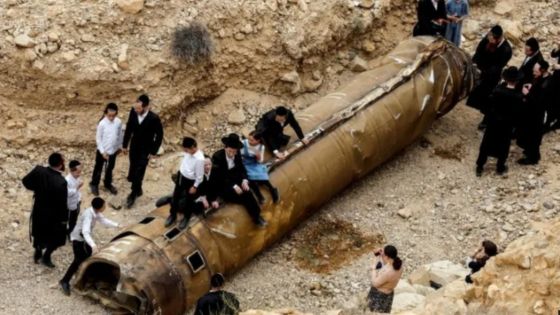As an Amazon Associate I earn from qualifying purchases.
The pace of news in the Middle East is relentless. One moment, the focus is on the unprecedented missile and drone exchanges between Iran and Israel, and the next, attention returns to the ongoing conflict and suffering in Gaza.
However, amidst the whirlwind of events, policymakers, analysts, and military leaders are still grappling with the recent intense exchange of fire between these long-standing adversaries. This confrontation, which narrowly avoided escalating into a catastrophic international conflict, has left many contemplating just how close they came to the brink and the depths of the potential consequences.
This marked the first direct attack between Iran and Israel, a significant milestone in their fraught relationship. Some experts have described Iran’s assault as the largest combined missile and drone attack ever witnessed, surpassing even Russia’s actions in Ukraine. Notably, it was the first external bombardment of Israel since Saddam Hussein’s Scud missile strikes in 1991.
Despite the majority of Iran’s 300-plus drones and missiles being intercepted or failing mid-flight, the spectacle of Israeli air defenses lighting up the night sky over Jerusalem was unmistakable. The gravity of the situation was palpable, with the potential for a single GPS guidance system malfunction to result in a missile striking an urban area, inflicting immense civilian casualties.
The events serve as a stark reminder of the fragile balance and the perilous consequences that hang in the balance in the volatile Middle East.
The weekend in question left many senior Western security officials reflecting on the precariousness of the situation. “I don’t think people realize how close we were that weekend,” remarked one official. “It could have been a very different story.”
However, some in the West see positive aspects in the events of April 13 and Israel’s subsequent measured response. They argue that the successful prediction of Iran’s strike was a significant intelligence achievement, highlighting the effectiveness of allied military cooperation in defending Israel, and suggesting that both Iran and Israel learned to de-escalate tensions.
The intelligence operation preceding the attack was particularly noteworthy. The US reportedly became aware of Iran’s plans on the Wednesday prior to the Saturday evening attack and learned of the scale of Iran’s intentions. This intelligence helped galvanize an international response and prompted countries in the Gulf, including Jordan and Saudi Arabia, to join Israel’s defense efforts.
While the exact roles of Jordan and Saudi Arabia are not fully clear, it’s known that Jordan shot down Iranian drones in self-defense and allowed Israeli warplanes some airspace access. The Saudis are believed to have provided intelligence to the US and monitored threats from Iranian-backed groups in Yemen.
The coordinated response demonstrated the capability of the US, British, French, Jordanian, and Saudi militaries to operate collectively in air defense. This successful operation has led some to speculate about the potential formation of a new regional alliance against Iran.
However, skeptics caution against viewing this crisis solely through a military lens. They argue that celebrating technological successes overlooks the broader political context. Some analysts question whether Iran’s restraint in the attack indicates a strategic decision or simply tactical considerations.
Emile Hokayem from the International Institute for Strategic Studies emphasizes the reliance of Israel on allies for defense and doubts the emergence of a new regional military alliance, attributing cooperation to a desire to avoid confrontation and demonstrate loyalty to Western allies.
Optimists contend that Iran and Israel both learned from the experience, accurately communicated their intentions, and demonstrated an ability to de-escalate without losing face. They suggest that the incident will serve to re-establish mutual deterrence between the two nations.
Military lessons have undoubtedly been gleaned by both sides. Iran’s attack likely provided insights into Israeli air defense strengths and weaknesses, while Israel and the US gained a deeper understanding of Iran’s tactical strategies.
In summary, while the events of that weekend were a cause for concern, they also provided valuable insights into the dynamics between Iran and Israel and highlighted the importance of international cooperation in managing regional tensions.
The recent events have sparked debate over whether both Iran and Israel have violated a longstanding taboo against direct attacks, potentially making such actions more feasible in the future.
Afshon Ostovar, in an essay for Foreign Affairs, argues that Iran’s sizable attack suggests a departure from a policy of restraint, indicating Iran’s intent to inflict a significant blow on Israel. Emile Hokayem challenges the notion that Iran and Israel have developed a deeper understanding of each other, highlighting the absence of direct communication between the two nations and the reliance on military posturing and intermediaries, which can lead to misinterpretation and escalation.
There is skepticism regarding whether deterrence has been re-established. Amos Harel, a defense analyst for Haaretz, points out that both nations breached previous rules of engagement with limited consequences, leaving the balance of deterrence between them uncertain.
Overall, the crisis underscores the perilous brinkmanship in the region and serves as a reminder of how close the situation came to escalating into full-scale war.
Amazon and the Amazon logo are trademarks of Amazon.com, Inc, or its affiliates.





